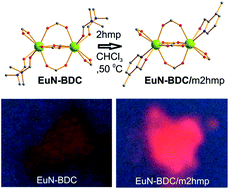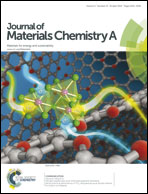Single crystal coordinating solvent exchange as a general method for the enhancement of the photoluminescence properties of lanthanide MOFs†
Abstract
The discovery of new methods for the post-synthesis modification of materials is essential in order to establish suitable strategies for the tuning of their properties in a rational manner. Here we present a series of single-crystal-to-single-crystal (SCSC) transformations for the flexible [Eu2(CIP)2(DMF)2(H2O)2] (UCY-8) [H3CIP = 5-(4-carboxybenzylideneamino)isophthalic acid] and rigid [Eu2(N-BDC)3(DMF)4] (EuN-BDC) (H2N-BDC = 2-amino-1,4-benzene dicarboxylic acid) Metal–Organic Frameworks (MOFs) that involve the replacement of their coordinating solvent molecules by terminally ligating organic molecules with multiple functional groups including –OH, –SH, –NH– and –NH2 or their combinations, chelating ligands, and two different organic compounds. The capability of the flexible MOF, which contains small pores and channels (<4 Å), to exchange its coordinating solvent molecules by relatively bulky molecules (such as pyridine, 2-hydroxymethyl-phenol, etc.) is shown to be the result of its breathing capacity. Remarkably, the rigid MOF is also highly capable of replacing its coordinating solvent molecules by bulky ligands, despite its small pores (2–5 Å) and lack of structural flexibility. Interestingly, the insertion of some organic ligands into the rigid MOF results in a significant modification of its framework structure and substantial expansion of its potential void space. Not only a plethora of exchanged analogues of these MOFs have been isolated and crystallographically characterized, but also, in some cases, a tremendous enhancement of their Eu3+-based photoluminescence (PL) signals, lifetimes and quantum yields (up to ∼16 times) compared to those of the pristine materials has been observed due to the replacement of terminal solvents by organic ligands being efficient sensitizers for the Eu3+ ion. Overall this work indicates that the Single Crystal Coordinating Solvent Exchange (SCCSE) can be applied as a general post-synthetic modification method for LnMOFs and also constitutes a highly efficient strategy for the enhancement of the Ln3+-based PL.


 Please wait while we load your content...
Please wait while we load your content...